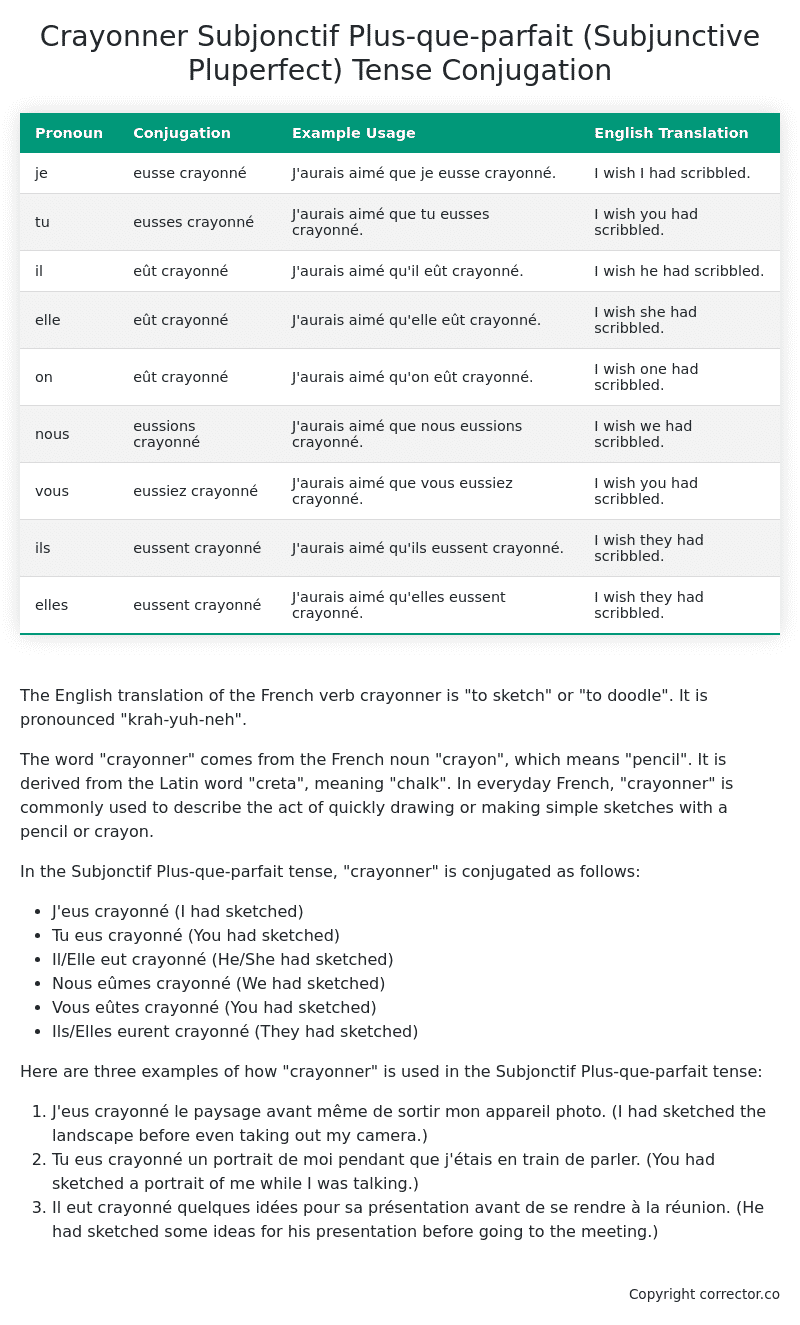Subjonctif Plus-que-parfait (Subjunctive Pluperfect) Tense Conjugation of the French Verb crayonner
Introduction to the verb crayonner
The English translation of the French verb crayonner is “to sketch” or “to doodle”. It is pronounced “krah-yuh-neh”.
The word “crayonner” comes from the French noun “crayon”, which means “pencil”. It is derived from the Latin word “creta”, meaning “chalk”. In everyday French, “crayonner” is commonly used to describe the act of quickly drawing or making simple sketches with a pencil or crayon.
In the Subjonctif Plus-que-parfait tense, “crayonner” is conjugated as follows:
- J’eus crayonné (I had sketched)
- Tu eus crayonné (You had sketched)
- Il/Elle eut crayonné (He/She had sketched)
- Nous eûmes crayonné (We had sketched)
- Vous eûtes crayonné (You had sketched)
- Ils/Elles eurent crayonné (They had sketched)
Here are three examples of how “crayonner” is used in the Subjonctif Plus-que-parfait tense:
- J’eus crayonné le paysage avant même de sortir mon appareil photo. (I had sketched the landscape before even taking out my camera.)
- Tu eus crayonné un portrait de moi pendant que j’étais en train de parler. (You had sketched a portrait of me while I was talking.)
- Il eut crayonné quelques idées pour sa présentation avant de se rendre à la réunion. (He had sketched some ideas for his presentation before going to the meeting.)
Table of the Subjonctif Plus-que-parfait (Subjunctive Pluperfect) Tense Conjugation of crayonner
| Pronoun | Conjugation | Example Usage | English Translation |
|---|---|---|---|
| je | eusse crayonné | J’aurais aimé que je eusse crayonné. | I wish I had scribbled. |
| tu | eusses crayonné | J’aurais aimé que tu eusses crayonné. | I wish you had scribbled. |
| il | eût crayonné | J’aurais aimé qu’il eût crayonné. | I wish he had scribbled. |
| elle | eût crayonné | J’aurais aimé qu’elle eût crayonné. | I wish she had scribbled. |
| on | eût crayonné | J’aurais aimé qu’on eût crayonné. | I wish one had scribbled. |
| nous | eussions crayonné | J’aurais aimé que nous eussions crayonné. | I wish we had scribbled. |
| vous | eussiez crayonné | J’aurais aimé que vous eussiez crayonné. | I wish you had scribbled. |
| ils | eussent crayonné | J’aurais aimé qu’ils eussent crayonné. | I wish they had scribbled. |
| elles | eussent crayonné | J’aurais aimé qu’elles eussent crayonné. | I wish they had scribbled. |
Other Conjugations for Crayonner.
Le Present (Present Tense) Conjugation of the French Verb crayonner
Imparfait (Imperfect) Tense Conjugation of the French Verb crayonner
Passé Simple (Simple Past) Tense Conjugation of the French Verb crayonner
Passé Composé (Present Perfect) Tense Conjugation of the French Verb crayonner
Futur Simple (Simple Future) Tense Conjugation of the French Verb crayonner
Futur Proche (Near Future) Tense Conjugation of the French Verb crayonner
Plus-que-parfait (Pluperfect) Tense Conjugation of the French Verb crayonner
Passé Antérieur (Past Anterior) Tense Conjugation of the French Verb crayonner
Futur Antérieur (Future Anterior) Tense Conjugation of the French Verb crayonner
Subjonctif Présent (Subjunctive Present) Tense Conjugation of the French Verb crayonner
Subjonctif Passé (Subjunctive Past) Tense Conjugation of the French Verb crayonner
Subjonctif Imparfait (Subjunctive Imperfect) Tense Conjugation of the French Verb crayonner
Subjonctif Plus-que-parfait (Subjunctive Pluperfect) Tense Conjugation of the French Verb crayonner
Conditionnel Présent (Conditional Present) Tense Conjugation of the French Verb crayonner
Conditionnel Passé (Conditional Past) Tense Conjugation of the French Verb crayonner
L’impératif Présent (Imperative Present) Tense Conjugation of the French Verb crayonner
L’infinitif Présent (Infinitive Present) Tense Conjugation of the French Verb crayonner
(this article)
Struggling with French verbs or the language in general? Why not use our free French Grammar Checker – no registration required!
Get a FREE Download Study Sheet of this Conjugation 🔥
Simply right click the image below, click “save image” and get your free reference for the crayonner Subjonctif Plus-que-parfait tense conjugation!

Crayonner – About the French Subjonctif Plus-que-parfait (Subjunctive Pluperfect) Tense
Formation
Common Everyday Usage Patterns
Hypothetical Situations
Reported Speech
Doubt, Wishes, and Emotions
Interactions with Other Tenses
Present Subjunctive
Imperfect Subjunctive
Conditional
Summary
I hope you enjoyed this article on the verb crayonner. Still in a learning mood? Check out another TOTALLY random French verb conjugation!


